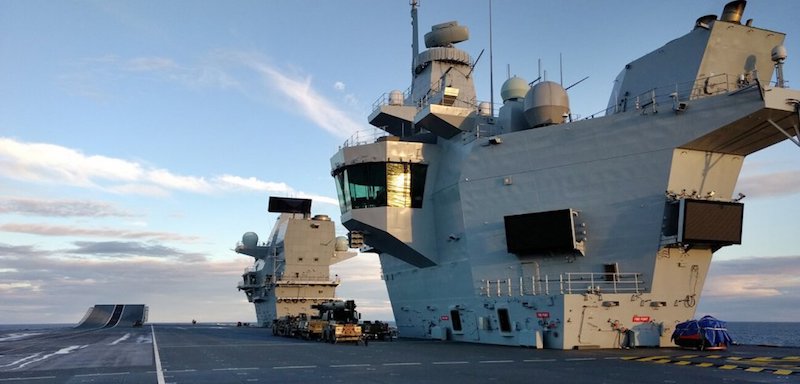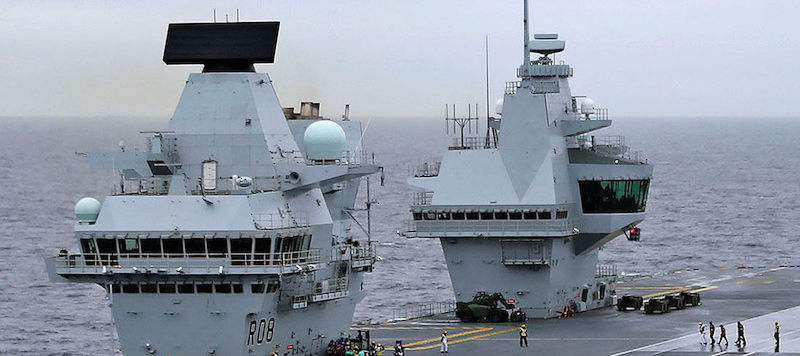
Many have wondered why HMS Queen Elizabeth has two ‘islands’. Here we consider why she is the first aircraft carrier in the world to adopt this unique arrangement and the benefits it brings.
Redundancy and separation can be good
In a moment of inspiration back in 2001, an RN officer serving with the Thales CVF design team developing initial concepts for what became the Queen Elizabeth Class, hit upon the idea of separate islands. There are several advantages to this design but the most compelling reason for the twin islands is to space out the funnels, allowing greater separation between the engines below. QEC has duplicated main and secondary machinery in two complexes with independent uptakes and downtakes in each of the two islands. The separation provides a measure of redundancy, it increases the chances one propulsion system will remain operational in the event of action damage to the other. Gas turbine engines (situated in the sponsons directly below each island of the QEC) by their nature require larger funnels and downtakes than the diesel engines (in the bottom of the ship). The twin island design helps minimise their impact on the internal layout.
In a conventional single-island carrier design, either you have to have a very long island (like the Invincible class) which reduces flight deck space or, the exhaust trunkings have to be channelled up into a smaller space. There are limits to the angles this pipework may take which can affect the space available for the hangar. The uptakes can also create vulnerabilities, the third HMS Ark Royal was lost to a single torpedo hit in 1941, partly due to progressive engine room flooding through funnel uptakes.
The twin island design has several other benefits. Wind tunnel testing has proved that the air turbulence over the flight deck caused by the wind and the ship’s movement, is reduced by having two islands instead of one large one. Turbulent air is a hindrance to flight operations and aircraft carrier designers always have to contend with this problem. Twin islands allow greater flight deck area because the combined footprint of the two small islands is less than that of a single larger one. By having two smaller islands it allowed each to be constructed as a single block and then shipped to Rosyth to be lifted onto the hull. The forward island was built in Portsmouth and the aft island built in Glasgow.
This arrangement solves another problem by providing good separation for the main radars. The Type 1046 long range air surveillance radar is mounted forward while the Type 997 Artisan 3D medium range radar is aft. Powerful radars, even operating on different frequencies, can cause mutual interference or blind spots if the aerials are mounted too close together. Apart from a slim communications mast, both the Artisan and 1046 have clear, unobstructed arcs.

The flag bridge below the main bridge can be clearly seen in the forward island. The emergency conning position and the large Flyco can be seen in the aft island. Note the tall funnels designed to keep exhaust gasses away from the flight deck
Bridge - forward
With separate islands it is possible to site the bridge further forward than in a conventional single-island design. This gives the officer of the watch (OOW) a better view of the bows and what is immediately ahead, especially useful when in confined waters. The QEC bridge is spacious and has very large windows with a wide field of view, similar to the Type 45 destroyers. Carpeted with a dark blue-grey finish and wooden trim around the control panels, it has a very different feel to the cream and pale grey interior of preceding Invincible class carriers. The QEC are fitted with a state of the art Sperry Marine Integrated Navigation Bridge System (INBS) including the Naval Electronic Chart Display and Information System (ECDIS-N).
The captain has a day cabin just behind the bridge for use at sea but as is usual on a carrier, his spacious main cabin is down aft with the other officer accommodation. There is a small lift that allows him to quickly get up or down from the bridge to the operations room which is situated seven decks below.
Like the Invincible class, the QEC has facilities for the Admiral commanding the carrier group and has use of his own ‘flag bridge’ below the main navigation bridge. It offers a good view and a useful space for his staff, away from the ship’s personnel.
Flyco - aft
The QEC aircraft control position, known as flyco is a major change in design philosophy. Instead of being just an appendage to the navigation bridge it has been designed in partnership with Tex ATC Ltd, one of the world’s leading providers of military and civilian airfield control towers. By siting the Flyco separately, it can be positioned in the optimum place to view aircraft as they approach the ship for landing. This is the moment when the pilot requires most help from the ship and a dedicated aircraft controller sitting in Flyco (usually a former pilot) can help talk the plane down if needed. The QEC flyco projects out from the aft island and has enormous 3-metre tall windows with providing a 290º view over the flight deck. Such tall windows allow a good view of high flying aircraft for all, including for the personnel sitting in the small raised gallery at the back of the Flyco. In some older ships, the cramped flyco position looked like an afterthought it was sometimes necessary to get right up close to the small windows to see high flying aircraft.
Flyco can issue instructions to the aircraft handlers on the flight deck via their headsets or using large LED displays mounted on the side of the aft island. It is also connected to the hangar control room below where orders are issued to prepare aircraft to be brought on deck. The Commander Air, “Wings” gets a day cabin in the aft island but does not have his own lift, like the Captain up forward. The aft island also features a ‘bridge’ which has replica ship controls and, in the event of damage to the forward island, could be used as the emergency conning position.
Drawbacks
For aircraft carrier veterans the completely separated bridge and flyco will take some adjustment. Because the ship’s course and speed need to be carefully coordinated with flying operations, the close proximity of the OOW to the flight controllers helped them work together. In the new arrangement, they will not be able to see each other and are reliant on the intercom. No doubt everyone will quickly adapt and the benefits of additional space for both navigators and flight controllers will outweigh any disadvantages. It is highly subjective, but some carrier ‘purists’ have said the twin islands make the QEC look “ugly”. Others see the QEC as quite beautiful and despite their quite angular shapes, represent just another step in the evolution of carrier design appropriate for the 21st Century.
The QEC will benefit from a ski-ramp to assist aircraft on take off and twin islands, both of which were invented by the RN. It is encouraging
Source: savetheroyalnavy.org

